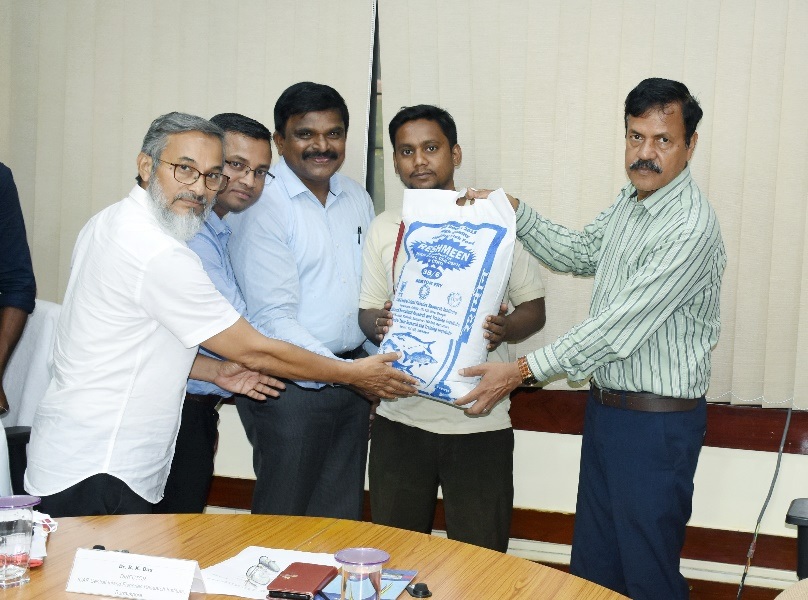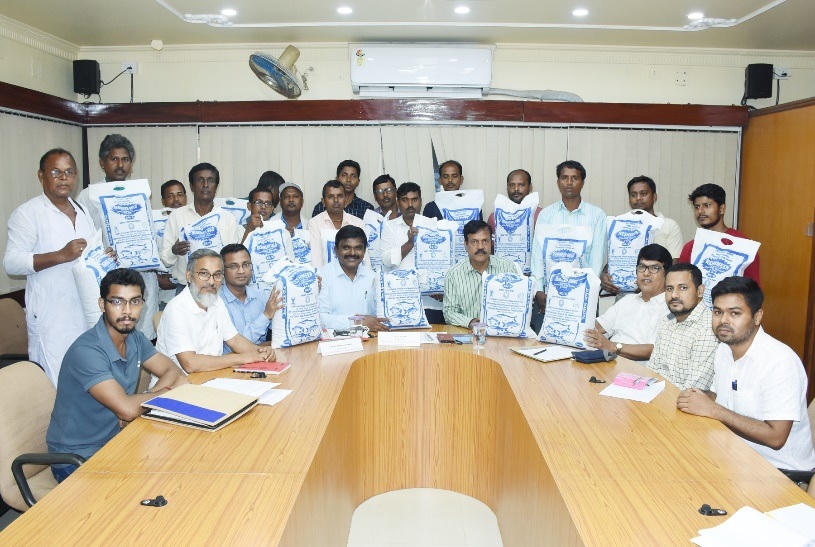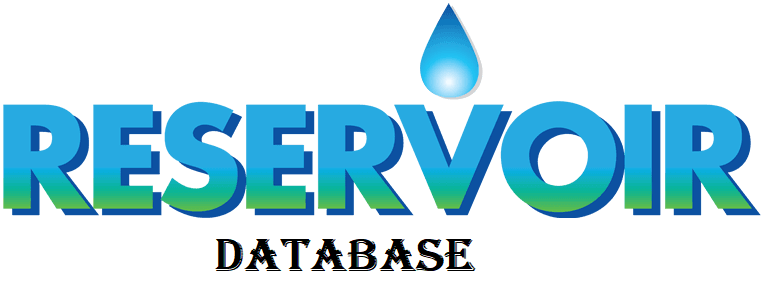Overview
Publications
Recruitment
Intranet
CIFRI Corners'
The silk worm pupae are a waste of silk industry which has a lot of resources across the country. In India five types of silk work waste are available among which mulberry has abundant resources. There is a need to have a strategy to convert these potential waste resources to wealth. With this background, ICAR-Central Inland Fisheries Research Institute (ICAR-CIFRI), Barrackpore ventured in a collaborative project with Central Tasar Research & Training Institute (CTRTI), Ranchi on “Utilisation and Diversification of Silkworm Pupae Products for Human & Animal Consumption and Composting”. The ICAR-CIFRI has been working on these types of novel areas of research since 2009 starting from Brewery waste to black soldier fly, and silkworm pupae. Institute has already commercialised one feed from Brewery waste namely, CIFRI CAGE GROW.
 Today, a review meeting for the collaborative project was held at ICAR-Central Inland Fisheries Research Institute (ICAR-CIFRI), Barrackpore. The programme commenced with the welcome address by Dr. B. K. Das, Director, ICAR-CIFRI, Barrackpore. In the welcome address Dr. Das welcomed Dr. K. Sathyanarayana, Director, and Dr. K. Jena, Scientist- D, Central Tasar Research and Training Institute (CTRTI), Ranchi. The programme was attended by the project team comprising Co-Principal Investigators, Dr. M.A. Hassan HoD, Fisheries Enhancement and Management (FEM) Division, Dr. D. K. Meena, Scientist (S.S.), Dr. Rahul Das, Scientist, project staff, and progressive fish famers (30 nos.) from the different places of West Bengal including Sunderbans. In the inaugural speech, Dr. Sathyanarayana thanked Dr. Das and his team for their sincere efforts towards the project. He emphasized upon the effective valorisation of the silkworm pupae for the conversion of silk industry waste to wealth in terms of cost-effective fish feed for candidate fish species. Dr. Das, the Principal Investigator of the Project, in his presentation appraised the project work and highlighted the significant achievements such as feed formulation and feasibility testing of SilkWorm Pupae Meal (SWPM) based fish feed in candidate fish species. A total of four complete feed of 1mm(fry), 2mm (fingerling), 3mm (grow-out), and 4mm (grow-out and brooder) pellet size were formulated and named as Reshmeen (CP-38%), Resmeen Amrit (CP-32%), Resmeen Gold+(CP-28%), and Reshmeen Gold (CP-25%), respectively.
Today, a review meeting for the collaborative project was held at ICAR-Central Inland Fisheries Research Institute (ICAR-CIFRI), Barrackpore. The programme commenced with the welcome address by Dr. B. K. Das, Director, ICAR-CIFRI, Barrackpore. In the welcome address Dr. Das welcomed Dr. K. Sathyanarayana, Director, and Dr. K. Jena, Scientist- D, Central Tasar Research and Training Institute (CTRTI), Ranchi. The programme was attended by the project team comprising Co-Principal Investigators, Dr. M.A. Hassan HoD, Fisheries Enhancement and Management (FEM) Division, Dr. D. K. Meena, Scientist (S.S.), Dr. Rahul Das, Scientist, project staff, and progressive fish famers (30 nos.) from the different places of West Bengal including Sunderbans. In the inaugural speech, Dr. Sathyanarayana thanked Dr. Das and his team for their sincere efforts towards the project. He emphasized upon the effective valorisation of the silkworm pupae for the conversion of silk industry waste to wealth in terms of cost-effective fish feed for candidate fish species. Dr. Das, the Principal Investigator of the Project, in his presentation appraised the project work and highlighted the significant achievements such as feed formulation and feasibility testing of SilkWorm Pupae Meal (SWPM) based fish feed in candidate fish species. A total of four complete feed of 1mm(fry), 2mm (fingerling), 3mm (grow-out), and 4mm (grow-out and brooder) pellet size were formulated and named as Reshmeen (CP-38%), Resmeen Amrit (CP-32%), Resmeen Gold+(CP-28%), and Reshmeen Gold (CP-25%), respectively.











